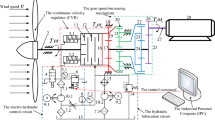Abstract
The generator torque control loop of a multi-MW wind turbine consists of three operational regions, i.e. a max Cp region, a transient region around the rated rotor speed, and a power regulation region. The performance and mechanical stress on the wind turbine structure are closely related with how the torque schedule is mechanized in the transient and above-rated regions. Using a drive train model, the closed loop dynamic characteristics for different torque schedules were analyzed. It is found that the slope of the torque for the rotor speed in the transient region is the major factor which determines the performance and mechanical loading of the wind turbine. The effect of using a variable torque instead of the fixed rated torque in the above-rated region is also analyzed.
Similar content being viewed by others
References
T. Petru and T. Thiringer, Modeling of wind turbines for power system studies, IEEE Trans. on Power Systems, 17(4) (2002).
F. D. Bianchi, H. D. Battisa and R. J. Mantz, Wind turbine control systems, principles, modeling and gain scheduling design, Springer (2007).
E. A. Bossanyi, The design of closed loop controller for wind turbines, Wind Energy, 3 (2000) 149–163.
Morten H. Hansen, Anca Hansen, Torben J. Larsen, Stig Øye, Poul Sørensen and Peter Fuglsang, Control design for a pitch-regulated, variable speed wind turbine, Risø-R-1500(EN) (2005).
E. van der Hooft, P. Schaak and T. van Engelen, Wind turbine control algorithm, ECN-C-03-11 (2003).
G. Leloudas, W. Zhu, J. Sorensen, W. Shen and S. Hjort, Prediction and reduction of noise for a 2.3MW wind turbine, Journal of Physics: Conference series, 75 (2007) 1–9.
S. Muller, M. Deicke and R. de Donker, Doubly fed induction generator systems for wind turbines, IEEE Industry Applications Magazine (2002) 26–33.
E. Bossanyi, GH Bladed user manual (version 3.81), Garrad Hassan and Partners, 282-BR-010 (2009).
T. Burton, D. Sharpe, N. Jenkins and E. Bossanyi, Wind energy handbook, A John Wiley and Sons, ISBN: 9780471489979 (2001).
IEC 61400-1, Wind turbines Part 1: Design requirement, International Electrotechnical Commission (2005).
M. Chinchilla, S. Arnaltes and J. C. Burgos, Control of permanent-magnet generators applied to variable speed wind energy system connected to grid, IEEE Trans. on Energy Conversion, 21(1) (2006) 130–135.
Yoonsu Nam, Jeong-gi Kim and Carlo L. Bottasso, Maximal power extraction strategy in the transition region and its benefit on the AEP(annul energy product), Journal of Mechanical Science and Technology, 25(6) (2011) 1613–1619.
Author information
Authors and Affiliations
Corresponding author
Additional information
Recommended by Associate Editor Cheolung Cheong
Yoonsu Nam was born in Suwon, Korea, in 1958. He receives his B.S. in Nuclear Engineering form Seoul National University, Seoul, Korea, in 1981. He received his M.S. from the Department of Machine Design, Seoul National University, in 1983. He received his Ph.D. in Mechanical GA, USA, in 1991. From 1983 to 1986, he was with the Central Research Institute of GoldStar (LG Electrinics) Inc., Korea. From 1992 to 1997, he was with the Flight Dynamics and Control Laboratory of the Agency for Defense Development, Daejeon, Korea. From 1997 to 2013, he was with the School of Mechanical and Mechatronics Engineering, Kangwon National University, Chuncheon, Korea. His research interests include mechanical load reduction control of MW class wind turbines.
Rights and permissions
About this article
Cite this article
Nam, Y., La, Y., Son, J. et al. The effect of torque scheduling on the performance and mechanical loads of a wind turbine. J Mech Sci Technol 28, 1599–1608 (2014). https://doi.org/10.1007/s12206-014-0306-0
Received:
Revised:
Accepted:
Published:
Issue Date:
DOI: https://doi.org/10.1007/s12206-014-0306-0




